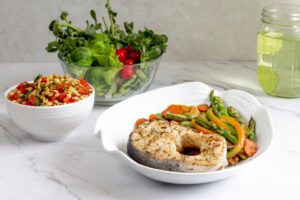The Health & Wellness Blog

How to Shop for Anti-Inflammatory Ingredients
Grocery shopping is overwhelming, especially if you want to eat heart-healthy. So cutting inflammation is usually a goal. I’ve learned that picking the right foods can help ensure a week of wholesome eating. What you put in your cart is just as important as what you put on your plate.
Buying anti-inflammatory foods does not require a total upheaval of one’s diet. It’s about being intentional — choosing foods that combat inflammation as opposed to stoking it. From fresh produce to healthy oils and spices, every aisle has something if you know what to look for.
In this guide, I will walk you through the grocery store with an anti-inflammatory mindset. Whether you’re starting from scratch or focusing on refining your journey, these tips will help make each trip to the grocery store a step forward toward better health.
Understanding the Core
An anti-inflammatory diet centres on eliminating inflammation-triggering foods. It can also mean including some foods that can help manage it. Chronic inflammation is associated with many health problems, including heart disease and arthritis. Knowing how ingredients affect inflammation helps you choose foods for your health goals.
Sugar, trans fat, and artificial additives in food can lead to inflammation. Eating whole foods full of antioxidants, fibre, omega-3 fatty acids, and phytonutrients boosts your body’s defences. Shopping with this knowledge helps you stock your pantry and refrigerator for healing.
Quick Guide
- Prioritise fresh produce: Dark leafy greens, berries, cruciferous vegetables, citrus.
- Opt for whole grains: Brown rice, quinoa, oats.
- Choose healthy fats: Extra virgin olive oil, avocado, nuts, and seeds.
- Look for omega-3-rich items: Fatty fish like salmon, flaxseeds, and chia seeds.
- Spice smartly: Turmeric, ginger, garlic, cinnamon.
- Read labels carefully: Avoid added sugars, hydrogenated oils, and excess sodium.
Step-by-Step Guide
1. Plan Before You Shop
Start with a list based on anti-inflammatory recipes. This helps cut down on impulse buys and keeps you focused on nutrient-rich options. Group your list by store sections—produce, pantry staples, proteins, etc.

2. Begin in the Produce Section
Fill your cart with colourful vegetables and fruits. Berries, tomatoes, broccoli, spinach, and kale are excellent choices. Buy seasonal and organic when possible to limit pesticide exposure.
Pro Tip: Bright colours usually mean high antioxidant content. Deeper colours tend to reduce inflammation.
3. Shop for Lean Protein and Omega-3 Sources
Choose wild-caught salmon, mackerel, and sardines when possible. For plant-based options, consider beans, lentils, and tofu. Eggs from pasture-raised chickens are also great if you eat them.
Important Tip: Keep canned salmon or tuna in your pantry for quick anti-inflammatory meals without fresh ingredients.
4. Choose the Right Carbs
Skip white bread and ultra-processed cereals. Instead, pick whole grains like quinoa, barley, and steel-cut oats. These provide fibre that supports gut health and helps fight inflammation.
5. Shop the Oil and Fats Section Wisely
Look for unrefined, cold-pressed oils. Extra virgin olive oil is a staple for anti-inflammatory cooking. Avocados and nuts like almonds and walnuts provide healthy fats too.
Pro Tip: Store nuts and oils in a cool, dark place to prevent oxidation, which can reduce their health benefits.
6. Visit the Spice Aisle
Stock up on anti-inflammatory spices like turmeric, black pepper (to enhance turmeric’s effects), ginger, and cinnamon. They add flavour and offer health benefits.
7. Don’t Skip the Freezer Section
Frozen berries, spinach, and peas can be just as nutritious as fresh ones. They’re great to have when fresh produce runs low.

8. Read Labels Diligently
When buying packaged items, check the ingredients list. Avoid items with added sugars, artificial preservatives, or hydrogenated oils. Look for whole ingredients you recognise.
Pro Tip: Fewer ingredients often mean a healthier option. A short, clean list is usually a good sign.
Important Notes
- Organic is helpful, but not mandatory: Focus on buying organic for the “Dirty Dozen” produce list, but don’t worry if you can’t go fully organic.
- Watch for hidden sugars: Many savoury foods like pasta sauces contain sneaky sugars. Always check the sugar content per serving.
- Sodium matters: Too much salt can lead to inflammation. Choose low-sodium versions of broth, canned beans, and sauces.
Best Practices and Additional Insights
Making consistent shopping habits leads to better health outcomes. Rotate your grocery list slightly each week to include different anti-inflammatory foods. A varied diet supports a healthy gut microbiome, which is crucial for reducing inflammation.
Batch cooking or prepping meals ahead of time also saves time and keeps you from reaching for unhealthy convenience foods.
When choosing beverages, skip sugary drinks and sodas. Opt for green tea, herbal infusions, or water infused with citrus or cucumber. These choices help keep you hydrated and inflammation at bay.
Pro Tip: Invest in reusable glass containers to store fresh ingredients. This keeps them fresher longer and reduces exposure to microplastics.

FAQs
What are the top anti-inflammatory foods to always have on hand?
Leafy greens, berries, turmeric, olive oil, nuts, fatty fish, and legumes are versatile staples.
Is it expensive to shop for anti-inflammatory foods?
It can be affordable with planning. Buy in bulk, shop seasonally, and use frozen items when fresh produce is too costly.
Can I still eat meat on an anti-inflammatory diet?
Yes, choose lean, grass-fed, or pasture-raised meats in moderation. Pair them with plenty of vegetables and healthy fats.
Do I need supplements for anti-inflammatory benefits?
Whole foods are great, but some people might need supplements. Omega-3s or turmeric with black pepper can help. So, talk to your healthcare provider.
Are dairy and gluten inflammatory?
That depends on the individual. Some may find dairy or gluten inflammatory, while others tolerate them well.
Make Every Cart Count
Shopping with an anti-inflammatory approach can put you in control of your health. This isn’t about being perfect; it’s about being intentional. Every choice you make — from produce to pantry — can contribute to healing and vibrancy. Eventually, these decisions are instinctual, making your kitchen a formidable agent for health and wellness. So, during your next grocery run, let it show the health you deserve.









